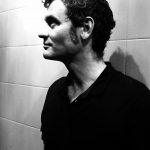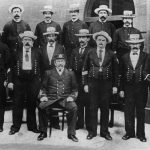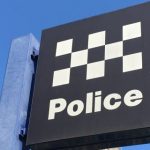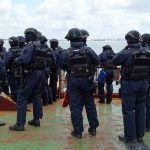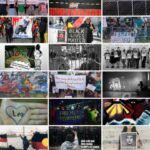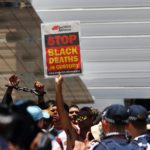Questionable Jurisdiction: Academic Amanda Porter on Policing First Nations

Under the settler colonial state of Australia, the rate of incarceration of First Nations peoples has seen them become the most incarcerated people on the planet.
The figures are stark. The 12,344 Aboriginal and Torres Strait Islander people locked up in the Australian prison system last December, equated to 29 percent of the entire adult prisoner population. However, First Nations people only account for 2.8 percent of the overall populace.
Despite decades-old calls for an end to Aboriginal deaths in the custody of police and corrections, there have been over 470 such deaths since a Royal Commission into the matter handed down 339 recommendations in 1991 – the majority of which remain unimplemented.
As the age of the nation of Australia rises, the situation for the sovereign peoples grows worse.
Thirty years ago, as the recommendations were made, First Nations people accounted for 14 percent of the adult prisoner population, a figure that has more than doubled.
And prejudicial policing is rife. NSW police disproportionately strip searches Aboriginal people. First Nations people are more likely to end up in court on minor offences. And a secret watchlist allows for the enhanced monitoring of targets, with the majority of youths listed being Aboriginal.
Imposing foreign force
From the early days of the colonising project, the imported authorities deployed paramilitary police forces to the frontiers. These consisted of the border police, the mounted police and the native police: First Nations troops under a single white commander.
Some of the chief duties of these forces was to quell the Aboriginal resistance, assist in the acquisition of Indigenous lands, and frontier officers were well-known for having taken part in the numerous massacres of sovereign peoples.
The border police, the mounted police and the native police were all forerunners to the 1862-established NSW Police Force. And in terms of how this state’s force operates – as well as those of other jurisdictions – the legacy of the early frontier years is obvious.
Yet, as Gomeroi, Dunghutti and Biripi activist Tameeka Tighe set out in the Guardian last month, prior to British arrival, the First Peoples of this continent had “existed peacefully for millennia” without the need for European-imposed policing and corrections systems.
An abolitionist lens
Dr Amanda Porter is Indigenous Programs senior fellow at the Melbourne Law School. The academic of Brinja Yuin descendent and European heritage has a focus on policing systems within settler colonial states and the violence they unleash.
Porter has long been advocating for and researching in regard to better justice outcomes for the First Nations people of this land. And she’s also a proponent of defunding the police and has a prison abolitionist outlook.

Sydney Criminal Lawyers spoke to academic Amanda Porter about how the early policing systems developed, the initial institutions designed to deprive First Peoples of their liberty, as well as the doubt the Mabo decision casts upon the legal jurisdiction of European policing systems in this land.
Firstly, sparked by the upsurge in the Black Lives Matter movement, the last year has seen a renewed focus on the systemic racism and brutality that First Nations people face at the hands of Australian policing and corrections systems.
Amanda, we’ve spoken before about how the attitude of early British law enforcement systems still informs the policing of Aboriginal and Torres Strait Islander peoples right now. So, how were the prejudicial systems of policing established?
It’s important to understand that in terms of the history of the police on this continent, there were two very different trajectories depending on whether you’re talking about Black populations, as opposed to white.
This further equates to whether you’re talking about the policing that took place inside the colonial settlement or at the colonial frontier.
At the frontier there were the native police, the border police and the mounted police. The mounted police have been described by historian Henry Reynolds as “the most violent institution in Australian history”.
However, what was happening inside the colonial settlements was a completely different story.
There was a different genealogy within the settlements. The earliest forms of policing inside the colonial settlement of Sydney Cove were the Sydney foot patrol and the water police formed in 1789.
They were interested in maintaining order and public safety within the settlement. They were concerned with the policing of the early British civilian population and the free convict population.
The personnel of what was initially called the night watch patrol were appointed by Governor Phillip, who sought nine of the best-behaved convicts to become the first police officers. In 1790, it was renamed the Sydney foot police, with many recruits drawn from the convict population.
There was a high turnover of staff due to dismissals and the standard of recruits was poor. Historian Mark Finnane estimates that in the year 1854 alone, over 179 of Sydney’s constabulary were dismissed for drunkenness.
In the mid-1800s, there was a period of professionalisation and consolidation of police in the different colonies. The NSW Police Act was passed in 1862 and the South Australian Police Act was enacted in 1844.
This is why policing today takes the form it does in Australia – it’s organised at the state or territory level, not at the district area, like the forces in the United States, the UK and Canada are.
With the state consolidated Police Acts for civilian populations, police powers were established. Those Acts gave police officers powers that they could draw on in order to intervene in, say, a civilian brawl.
Were the powers in these consolidated Acts applied to both British and First Nations populations in a similar manner?
Following this consolidation process policing remained very different whether you were white or Black. These laws gave police certain powers, but they were also given further extremely broad powers under the various state Aborigines Protection Acts.
These were whole separate pieces of legislation with powers to govern Aboriginal and Torres Strait Islander people, which contrasted with the way that police could intervene within the white population.
The police powers to intervene in Aboriginal populations were radically different. They had the power to remove an Aboriginal child from their family, the power to place an Aboriginal person on a reservation and to govern their daily lives in many ways—seeing a doctor, going to school, and so on.
So, how did this period of legislating police powers equate on the frontier?
Frontier police were for the most part professional recruits who were drawn from the British military. They were paid a stipend by the British Imperial Army.
The frontier police consisted of three separate forces: the mounted, the border police and the native police, which consisted of Aboriginal troops working under a single European officer.
In my reading of police histories, the bodies that oversaw the policing of the frontier were extrajudicial. You can’t look up a piece of legislation where their powers had been enacted. So, there were murders and deaths, and no one could ever be held to account.
Another important point to make is that the involvement of police in the massacre of First Nations people wasn’t something confined to the 18th and 19th centuries.
The Bedford Downs and the Coniston massacres happened in the early 20th century. The Skull Creek massacre involving the Western Australian police took place in 1975.
People don’t realise how recent this was. We’re talking direct police involvement in state-sanctioned massacres. And we can’t just refer to this in terms of history, because the violence of policing continues to this day.
There is also an unresolved issue of jurisdiction with respect to Aboriginal and Torres Strait Islander polities and the state.
This is why policing and the criminal jurisdiction remain one of the most significant sites of the ongoing colonisation of Aboriginal and Torres Strait Islander peoples today. And it always has been.
The Frontier Wars have never ended. Police are still enforcers of property and alien laws. They still enforce the illegal occupation of sovereign Aboriginal land.
This understanding is part of the remit of abolition politics and resistance. And part of that is about giving land back or paying the rent.
So, how do the vestiges of the earlier mandates of these frontier forces continue to influence policing practices today?
I don’t believe anything has changed. The Frontier Wars have never ended. This is borne out now through deaths in custody, as well as with missing and murdered Aboriginal women and children.
When I say that the wars have never ended, people need to understand the significance of the Mabo decision, in the context of where we are today with there being no treaty between Aboriginal and Torres Strait Islander peoples and the state.
This means that the authority from which police purport to operate from, when it comes to policing Indigenous people, is more complex than people are willing to concede.
In terms of the 1992 Mabo decision, you’re pointing to the finding that terra nullius was a falsehood?
Yes. Aboriginal sovereignty obviously predates settler sovereignty, and Aboriginal obligations to Country are still very much ongoing – now more than ever with the climate emergency.
In terms of the settler claims to sovereignty of this nation, the highest court of Australia said that the authority from which the settler state derives its authority – the Doctrine of Discovery and terra nullius – is a legal fiction.
This is why Mabo is critical. Here you have the highest court of Australia saying that the doctrine from which the settler system derives its validity is a legal fiction – that it is an imaginary settler storytelling.
This further raises serious questions about the legitimacy to govern on this land – not just from a moral or ethical perspective – but from a legal perspective.
Aboriginal law and settler law continue side by side, even though they don’t recognise one another.
But Mabo, and later cases such as Walker v NSW, raise significant questions around settler law and the policing of Aboriginal people in the absence of a treaty.
Professor Mick Dodson put it nicely when he said that “the foundations of the sovereignty of the Australian state remains a mystery. The sovereign pillars of the Australian state are arguably, at the very least, a little legally shaky.”
So, this question of jurisdiction would have bearing on early European corrections systems operating in relation to First Nations peoples.
Were there differences in how the early prison system operated in regard to the British and Aboriginal and Torres Strait Islander populations?
The corrections systems raise those same questions around governance, authority and legitimacy, as Indigenous people have always been outside and beyond the remit of the law in these ways.
There was the history of the penal colony, which was all about the convict class and the free settlers. But what happened in terms of the incarceration of Aboriginal people was completely different.
Again, extending the colonial frontier involved violence, massacres and forced displacement. Aboriginal dissidents and agitators were sent to penal reformatories like Rottnest Island and Palm Island.
Another form of management was the creation of Aboriginal reserves. These were areas of containment, which were policed in terms of who could enter or leave, via the powers in the Aborigines Protection Act, in its various iterations, over time and in different states and territories.
So, how does this question of jurisdiction sit for the First Nations people making up 29 percent of the adult prisoner population in this country right now?
It raises the same issues around the colonial frontier and citizenship. It goes to the heart of policing, governance and illegal occupation.
Many Aboriginal and Torres Strait Islander people don’t identify as Australian. A lot of people are working every day to overcome this situation. There’s the work being done to rebuild Indigenous nations and communities, and taking care of Country.
There’s the work that Jumbunna Institute of Indigenous Education and Research has done observing the governance structures of the Ngarrindjeri and Wiradjuri Nations. ANU scholars have conducted research looking at Indigenous governance.
There’s the work of Murrumu up in Cairns. He’s been putting in place a system of self-governance for Yidindji citizens. There’s also the work Shirleen Campbell and the Tangentyere Women’s Safety Group have done in promoting community safety.
There are also countless other documents involving commissions and inquiries, such as the Australian Law Reform Commission report into Aboriginal Customary Law, or Professor Marcia Langton’s submission, Too Much Sorry Business, to the Royal Commission into Aboriginal Deaths in Custody.
These are examples of systems operating outside of Australia. And a lot of non-Indigenous people don’t seem to understand that the white law is seen by Aboriginal people as illegitimate in many ways and the police are enforcers of an illegal occupation of Aboriginal land.
And lastly, Amanda, suggestions have been made that the Black Lives Matter movement has caused a global shift in the understanding and support of the Palestinian cause.
How do the BLM movement, the cause of Palestine and the movement for First Nations rights on this continent intersect? And has the recent BLM resurgence impacted the perception of First Nations issues amongst the broader Australian public?
There has been a long history of transnational solidarity, whether that’s with the Black Lives Matter movement or with the Black Panther movement, which came to Sydney and Brisbane back in the early 70s to help set up the Pig Patrols.
There’s this long history of transnational convergence with the African American cause, the cause of Palestine and Aboriginal people here. And it’s great to see that this solidarity is happening again.
All of these causes are eventually the same fight. They’re fights about racist violence, settler colonial violence and the illegal occupation of Indigenous land. It’s exactly the same struggle and solidarity between these movements.
What’s been happening lately is that via social media, with video footage being shared on these platforms, people are being confronted with images of Israel bombing a media tower or a children’s refuge, which means more people are having this conversation in the mainstream.
But the solidarity between these movements has always existed. These aren’t things that have manifested suddenly.
This solidarity goes back decades. When Rodney King was beaten up by police in LA, there was the same sort of support here. When Trayvon Martin was killed, you heard about it at rallies here. Indigenous people on Turtle Island know who Dylan Voller is.
And there has been the same solidarity between Indigenous people and refugees, through visa and passport ceremonies, such as the work of Gunnai and Gunditjmara man Robbie Thorpe and many others.
But whether there has been a shift in the broader Australian understanding, I’m not sure.
From the attendance at recent rallies, and from general conversations, there is that impression that there’s some awareness among settlers that they’re living on stolen Aboriginal land.
I just don’t think the full weight of that has sunk in yet for a lot of settler Australian citizens in terms of what it means to live ethically and morally on stolen Aboriginal land – but Australia as a nation has to move towards this.
Australia has a lot to reconcile—morally, ethically and legally. And I don’t think moral and legal issues are necessarily reconcilable.
